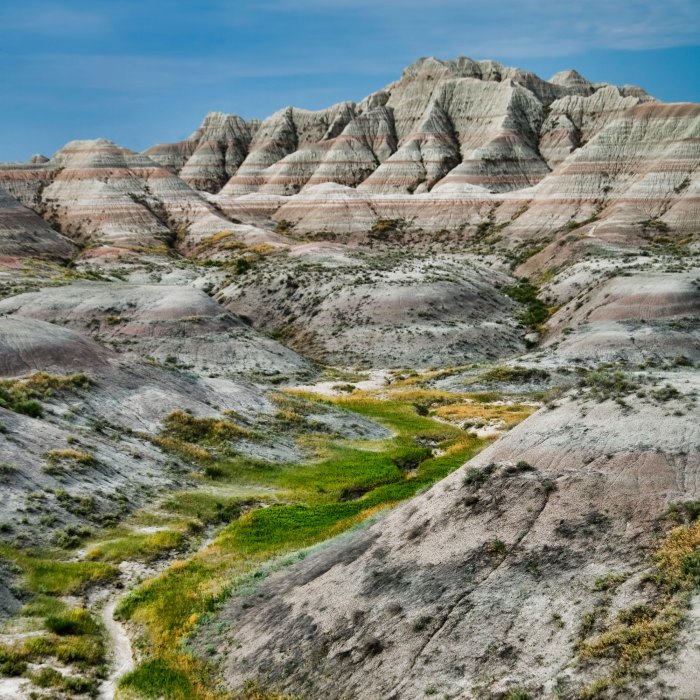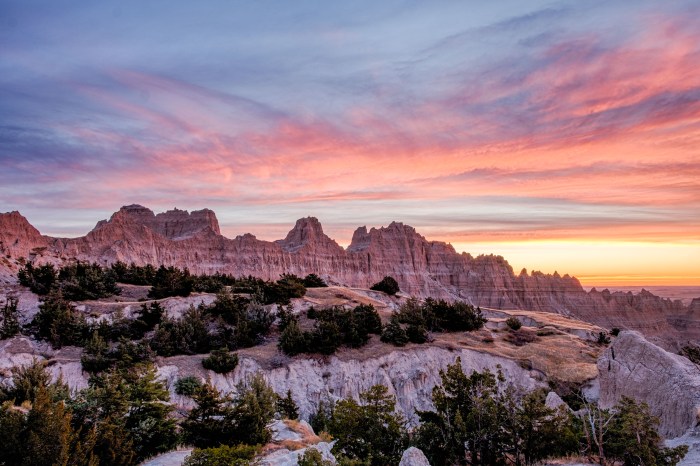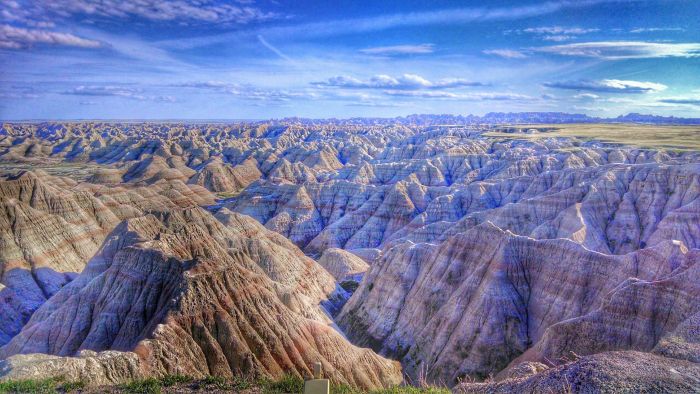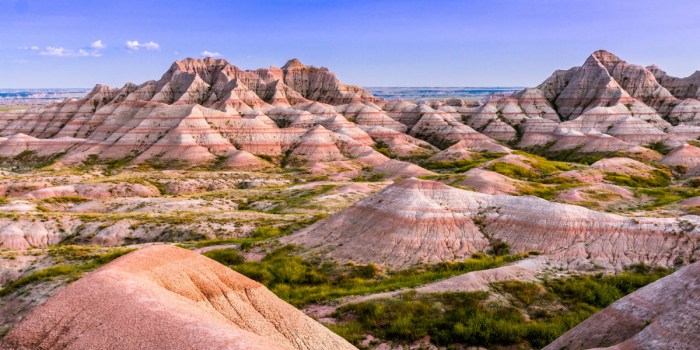Badlands National Park, a captivating expanse of rugged landscapes and rich history, invites visitors to explore a world of geological marvels, diverse wildlife, and cultural significance. From its mesmerizing spires and canyons to its paleontological treasures and Native American heritage, this park offers an unforgettable journey into the heart of the American West.
Within its vast boundaries, Badlands National Park unveils a tapestry of natural wonders. Its unique geological formations, shaped by millions of years of erosion, paint a vibrant canvas of colors and textures. The park’s diverse wildlife, including bison, pronghorn antelope, and prairie dogs, roams freely amidst the rugged terrain, while its plant life thrives in a symphony of colors and adaptations.
Natural Features

Badlands National Park, located in South Dakota, is a testament to the immense power of erosion and the unique geological forces that have shaped the landscape over millions of years. The park’s striking formations, diverse wildlife, and rich paleontological record offer a glimpse into the Earth’s dynamic past.
Geological Formations
The park’s most iconic feature is its rugged badlands, a series of steep, eroded hills and canyons. These formations were created by the relentless erosion of the White River Badlands, which began about 30 million years ago. As the river cut through the soft sedimentary rock, it created a network of gullies and ravines, which were later widened by wind and rain.
Wildlife and Vegetation
Despite its harsh and unforgiving landscape, Badlands National Park supports a diverse array of wildlife. The park is home to bison, pronghorn, bighorn sheep, and prairie dogs, as well as a variety of birds, reptiles, and amphibians. The vegetation in the park is primarily composed of shortgrass prairie and mixed-grass prairie, with some areas of riparian woodland along the riverbanks.
Paleontological Discoveries
Badlands National Park has yielded a wealth of paleontological discoveries, including the fossilized remains of ancient mammals, birds, and reptiles. One of the most famous discoveries was the fossil of a giant titanosaur, a massive dinosaur that lived in the area during the Cretaceous period. The park’s Fossil Preparation Laboratory provides visitors with a behind-the-scenes look at the work of paleontologists as they prepare and study these ancient specimens.
Badlands National Park is a rugged and beautiful landscape with towering spires, deep canyons, and colorful rock formations. Visitors can explore the park on foot, by bike, or by car, and there are also opportunities for camping, fishing, and wildlife viewing.
While you’re in the area, be sure to check out cultural tours in Europe to learn about the rich history and culture of this region. And don’t forget to stop by the Badlands National Park Visitor Center to learn more about the park’s geology, ecology, and human history.
Visitor Activities
Badlands National Park offers a diverse range of activities for visitors to enjoy the unique landscapes and wildlife. From challenging hikes to educational programs, there’s something for everyone to experience.
Badlands National Park, a sprawling wonderland of rugged buttes and canyons, beckons adventurers to explore its otherworldly landscapes. While in the area, consider adjusting your watch to austin time , as the park lies within the Central Time Zone. Immerse yourself in the park’s ancient history, where towering rock formations tell tales of a time when this arid expanse was once a lush subtropical forest.
Hiking Trails, Badlands national park
Badlands National Park boasts an extensive network of hiking trails that cater to various fitness levels. Some of the popular trails include:
- Door Trail: An easy 0.5-mile loop that leads to a scenic overlook of the White River Valley.
- Notch Trail: A moderate 2.4-mile hike that offers panoramic views of the badlands formations.
- Cliff Shelf Nature Trail: A strenuous 1-mile trail that follows the edge of a sheer cliff, providing stunning views.
Camping and Lodging
Visitors can choose from various camping and lodging options within Badlands National Park. The park has three campgrounds that offer a range of campsites, from primitive to full hookups.
There are also several lodges and motels located near the park, providing comfortable accommodations for those who prefer not to camp.
Guided Tours and Educational Programs
Badlands National Park offers a variety of guided tours and educational programs to enhance visitors’ understanding of the park’s natural and cultural history. These include:
- Ranger-led hikes: Explore the park with an experienced ranger who provides insights into the geology, wildlife, and history of the area.
- Junior Ranger program: A fun and educational program for children to learn about the park and earn a Junior Ranger badge.
- Night sky programs: Experience the pristine night sky with a ranger who shares knowledge about astronomy and the park’s nocturnal wildlife.
Cultural Significance
The Badlands National Park holds immense cultural significance as it preserves the rich heritage of Native American tribes who have inhabited the area for centuries.
The park protects sacred sites, including burial grounds, vision quest sites, and rock art panels, which serve as tangible evidence of the cultural and spiritual practices of the Lakota, Cheyenne, and other tribes.
Badlands National Park, with its rugged canyons and towering spires, offers a unique and awe-inspiring landscape. For those seeking a different kind of adventure, the nearby Bandelier National Monument is home to ancient cliff dwellings and petroglyphs, providing a glimpse into the rich cultural heritage of the region.
But returning to Badlands National Park, one can’t help but marvel at the stark beauty of its desolate landscapes, where nature’s forces have sculpted a breathtaking masterpiece.
Native American History
The Badlands have been home to Native American tribes for thousands of years. The Lakota Sioux, who were the first to inhabit the area, called it “mako sica,” meaning “bad lands.”
The Cheyenne and Arapaho tribes also lived in the Badlands, and they used the area for hunting, fishing, and gathering.
Role of the Park in Preserving Cultural Heritage
The Badlands National Park was established in 1978 to protect the unique natural and cultural resources of the area.
The park works closely with Native American tribes to preserve their cultural heritage and ensure that their traditions are passed on to future generations.
Importance for Cultural and Spiritual Practices
The Badlands National Park is a place of great cultural and spiritual significance for Native American tribes.
The park provides a place for tribes to gather for ceremonies, vision quests, and other traditional practices.
Conservation and Management

Badlands National Park is a rugged and beautiful landscape that requires careful management to preserve its unique features and protect its wildlife. The park’s conservation efforts focus on:
- Protecting the park’s ecosystems, including its grasslands, shrublands, and riparian areas.
- Managing the park’s wildlife populations, including its bison, pronghorn, and bighorn sheep.
- Controlling invasive species, such as cheatgrass and knapweed.
- Providing for recreational opportunities while minimizing the impact on the park’s resources.
Challenges Faced in Managing the Park’s Ecosystem
The park’s managers face a number of challenges in managing the park’s ecosystem. These challenges include:
- The park’s remote location makes it difficult to access and manage.
- The park’s climate is extreme, with hot summers and cold winters.
- The park’s geology is complex, with a variety of rock formations and soil types.
- The park is home to a number of invasive species, which can compete with native plants and animals.
- The park is a popular destination for visitors, which can put stress on the park’s resources.
Ongoing Research and Monitoring Programs
The park’s managers conduct a variety of research and monitoring programs to help them understand the park’s ecosystem and make informed management decisions. These programs include:
- Monitoring the park’s wildlife populations.
- Studying the park’s vegetation.
- Tracking the spread of invasive species.
- Assessing the impact of climate change on the park.
Historical Background: Badlands National Park

Badlands National Park, with its striking geological formations and rich cultural heritage, was established in 1978 to preserve and protect its unique landscapes and resources.
The park’s early exploration dates back to the mid-19th century, when fur traders and explorers ventured into the rugged terrain. In 1854, Lieutenant John G. Parke led an expedition through the area, describing it as “a desolate and forbidding country, without water, timber, or grass.”
Early Development and Conservation
Despite its inhospitable appearance, the Badlands attracted the attention of conservationists in the early 20th century. In 1929, President Calvin Coolidge designated the area as a national monument, recognizing its geological and paleontological significance.
In the 1930s, the Civilian Conservation Corps (CCC) played a vital role in developing the park’s infrastructure, including roads, trails, and visitor facilities. The CCC also implemented conservation measures, such as erosion control and wildlife management, to protect the park’s resources.
Artistic Depictions

The mesmerizing landscapes of Badlands National Park have long captivated the imaginations of artists and photographers, inspiring them to capture its ethereal beauty through various mediums.
One of the most famous artists to depict the park’s unique formations is Thomas Moran, a renowned landscape painter known for his dramatic representations of the American West. Moran’s 1870 painting “The Grand Canyon of the Yellowstone” portrays the Badlands’ rugged cliffs and spires with vibrant hues and an almost otherworldly atmosphere.
Notable Works of Art
- “The Badlands” (1890) by Henry Farny: This oil painting captures the park’s vastness and solitude, with a lone Native American figure gazing out over the desolate landscape.
- “Badlands at Sunset” (1917) by Ansel Adams: A black-and-white photograph that showcases the park’s dramatic play of light and shadow, with the setting sun casting long shadows across the eroded hills.
- “Badlands Symphony” (1994) by Linda Huff: A contemporary oil painting that uses vibrant colors and abstract brushstrokes to evoke the park’s vibrant geological formations.
Closure

As we bid farewell to Badlands National Park, its enduring legacy continues to inspire and captivate. Its conservation efforts ensure the preservation of this extraordinary ecosystem for generations to come, while its cultural significance weaves a timeless thread through the fabric of our collective history. Badlands National Park stands as a testament to the power of nature and the resilience of the human spirit, inviting us to marvel at its beauty and to cherish its invaluable treasures.
FAQ Summary
What is the best time to visit Badlands National Park?
Spring and fall offer the most pleasant weather for exploring the park, with moderate temperatures and fewer crowds.
What hiking trails are recommended for beginners?
The Notch Trail and the Fossil Exhibit Trail are relatively easy and provide scenic views of the park’s formations.
Can I camp overnight in the park?
Yes, there are several campgrounds within the park, including Cedar Pass Campground and Sage Creek Campground.
What wildlife can I expect to see?
Bison, pronghorn antelope, prairie dogs, and a variety of bird species are commonly seen throughout the park.